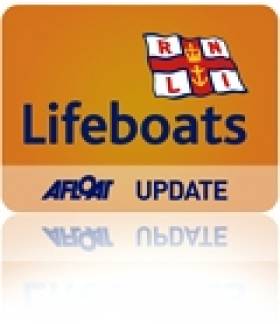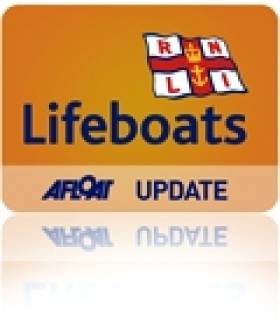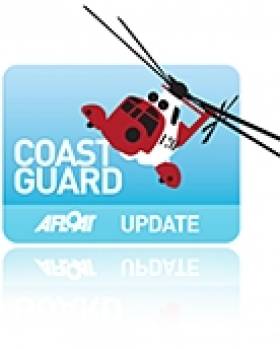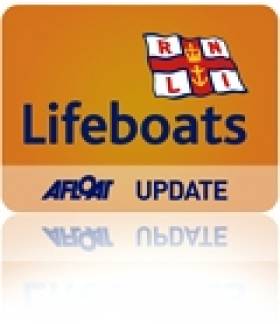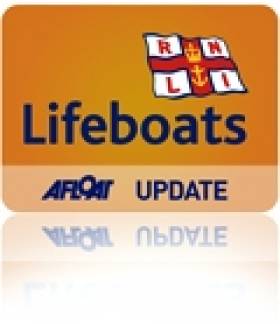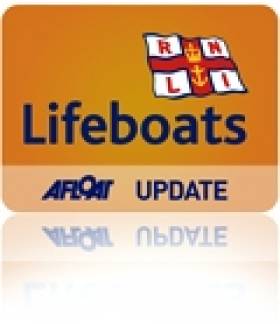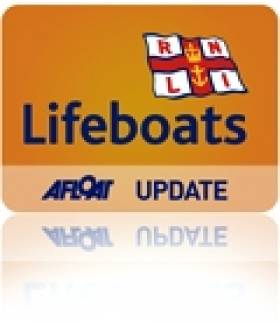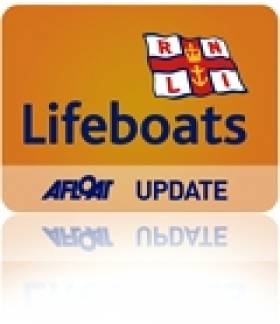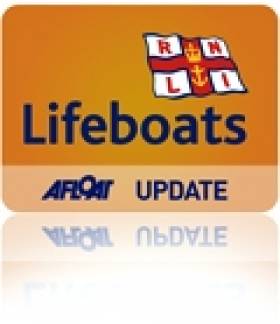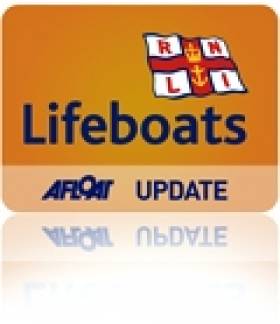Displaying items by tag: Lifeboats
At 5.45pm yesterday evening Monday July 5th, Fenit RNLI Lifeboat launched to assist a 40 foot Catamaran which was taking on water. The vessel which had left Donegal en route to France was 20 miles west of Loop Head and there were 2 people on board.
On arriving at the location of the stricken vessel volunteer crew members with Fenit RNLI Lifeboat immediately boarded the catamaran with a salvage pump and proceeded to pump the water from the vessel. Once they were happy that this process was working satisfactorily they put the vessel on tow and proceeded towards Fenit.
On arrival back in Fenit just before 1am this morning, arrangements were in place by Fenit RNLI members on shore and the catamaran was lifted onto the Pier by the Fenit Harbour Board Crane.
iPhone Co-Ordinates Save Stricken Vessel
A stricken vessel was located in trouble on Lough Erne using lat/long data from an iPhone.
A 999 call from the Motor Cruiser ‘Wee Rascal’ on Lough Erne in the early hours of this morning called on all the investigative powers of Belfast Coastguard as the vessel wasn’t even close to its reported position.
The vessel was on passage from Kesh to Enniskillen in windy, wet conditions when it called 999 to ask for assistance. Despite an extensive search of the area around its reported position neither the Enniskillen RNLI Inshore Lifeboat nor Erne Coastguard Rescue Teams could find the vessel.
Because the vessel had no flares, flash lights or VHF Radio on board to show rescuers where it was, Belfast Coastguard resorted to mobile phone technology. A locator i-phone application finally gave rescuers the vital latitude and longitude they needed to locate the vessel
The vessel was finally located 25 miles away from its reported position, dangerously amongst the rocky shoreline off Eagle Point. It was carefully brought away from the rocks by the skill of the Enniskillen RNLI Inshore Lifeboat crew and taken to the safety of Beleek marina.
Coastguard Watch Manager Steven Carson said:
“A combination of luck and technology saved these four people from imminent danger this morning. They had charts onboard but obviously no real idea of how to get to their destination or how to report their position in an emergency.
“Vital hours were wasted eliminating one possible location after another, time that we wouldn’t have had if the vessel had struck the rocks and sunk. I hope that this experience will help the crew to realise why navigation training is essential for all mariners, whether you’re on a Lough or the open sea.”
Lost Vessel Saved From Lough Erne Rocks
A 999 call from the Motor Cruiser ‘Wee Rascal’ on Lough Erne in the early hours of this morning called on all the investigative powers of Belfast Coastguard as the vessel wasn’t even close to its reported position.
The vessel was on passage from Kesh to Enniskillen in windy, wet conditions when it called 999 to ask for assistance. Despite an extensive search of the area around its reported position neither the Enniskillen RNLI Inshore Lifeboat nor Erne Coastguard Rescue Teams could find the vessel.
Because the vessel had no flares, flash lights or VHF Radio on board to show rescuers where it was, Belfast Coastguard resorted to mobile phone technology. A locator i-phone application finally gave rescuers the vital latitude and longitude they needed.
The vessel was finally located 25 miles away from its reported position, dangerously amongst the rocky shoreline off Eagle Point. It was carefully brought away from the rocks by the skill of the Enniskillen RNLI Inshore Lifeboat crew and taken to the safety of Beleek marina.
Coastguard Watch Manager Steven Carson said:
“A combination of luck and technology saved these four people from imminent danger this morning. They had charts onboard but obviously no real idea of how to get to their destination or how to report their position in an emergency.
“Vital hours were wasted eliminating one possible location after another, time that we wouldn’t have had if the vessel had struck the rocks and sunk. I hope that this experience will help the crew to realise why navigation training is essential for all mariners, whether you’re on a Lough or the open sea.”
Members of Ballyglass RNLI responded to an emergency callout yesterday (Sunday 20 June 2010) afternoon for a man reported missing after he went swimming in a remote mountain lake outside Bangor Erris in County Mayo. The volunteer lifeboat crew were unable to take their inshore lifeboat inland to the lake as the location was extremely remote but they are trained in search and rescue techniques and were called on to assist.
The request for help was received by Ballyglass RNLI Coxswain JT Gaughan from the Gardai at 4.10pm yesterday (Sunday 20 June 2010) when the girlfriend of the man reported him missing after he had gone for a swim in Stoney Lake. The mountain lake is three miles from the nearest road and in very rough terrain. The lifeboat crew along with the Gardai, Belmullet Sub Aqua Club, the Coast Guard and members of the North Western Regional fisheries board immediately went to give assistance.
Due to the remote access of the lake the Irish Coast Guard helicopter carried the search and rescue teams as near to the location as it could safely land and a search of the lake commenced. The search was called off at 10.30pm and was resumed first thing this morning. A man was recovered at approximately 10am and pronounced dead at the scene. His body has been taken to Castlebar hospital.
Commenting on the callout Ballyglass RNLI Coxswain JT Gaughan said, "this was a very sad and difficult callout for all involved. Everyone in the community and the various search and rescue agencies worked together in extremely challenging conditions to search for the young man. Our condolences go out to his family and friends."
Man Found Safe and Well
The man whom had been thought missing near Baltimore in West Cork has been located safe and well. All rescue services have been stood down. It is a reminder of the importance of letting people know where you are and where you are going.
Both Baltimore Lifeboats Launch on Rescue Missions
Both the all-weather lifeboat and inshore lifeboat based in Baltimore Harbour were called to give assistance on Saturday evening 19th June.
The inshore lifeboat Bessie was called at 18:45 to standby a 58ft motor yacht that was disabled and adrift in Glandore Harbour having hit a rock. Helmsman Youen Jacob assisted by crewmen Kieran Collins and Diarmuid Collins stoody by alongside the Courtmacsherry lifeboat as the motor yacht was towed to safety in Union Hall.
The inshore lifeboat has just been returned to its compound on the pier, when a second alert was raised at 22.25. This time the all-weather lifeboat Hilda Jarrett, responded to a medical emergency on Cape Clear Island. The Public Health Nurse stabilised the casualty prior to the young man being taken on board at North Harbour on Cape Clear Island.. The ambulance service met the lifeboat on its return to Baltimore to transfer the casualty to hospital. The lifeboat was returned to base at 00.10 on Sunday morning. Coxswain Kieran Cotter, was assisted by his crew of Micheal Cottrell, Don O’Donovan, Diarmuid Collins, Brian Ormond, Simon Duggan and John O’Flynn. Remarkably Baltimore lifeboats newest recruit, Diarmuid Collins, attended at both calls.
These two incidents demonstrate the versatility of the RNLI lifeboat capacity at Baltimore. The inshore lifeboat is a twin engine Atlantic 75 RIB, purpose designed for rapid response to inshore emergencies, whilst the larger all-weather lifeboat is suited to long range calls and medical evacuations.
Crosshaven Lifeboat Rescues 18-foot Yacht
Crosshaven RNLI Lifeboat went to the aid of an eighteen foot yacht on passage from the Kinsale area to Crosshaven this evening. The yacht with two persons on board suffered mechanical failure and was having trouble making way into a headwind.
Initially, the yacht was assisted by the motor Cruiser “Callie” who took them on initial tow and informed the Coastguard in Valentia who made the decision to Launch the Crosshaven lifeboat at 7pm. The Volunteer crew made up of Helm Con Crowley with Vincent Fleming and Ritchie Kelleher made their way to the rendezvous between the Cork Bouy and Rennies Point and relieved the motor cruiser of the tow. Crewman Ritchie Kelleher
Boarded the yacht and helped rig the tow for the 40 minute journey back to Crosshaven where the yacht was secured.
Swansea Lifeboat in Multiple Rescues
The warm weather has brought on a string of incidents for Swansea Coastguard, who this afternoon have co-ordinated several rescues, including three missing children, a capsized kayak and an injured jet-skier.
Several resources in particular were sent by Swansea Coastguard to assist in the search for a 5-year-old girl at Burnham-on-Sea beach this afternoon. The girl was reported missing via a 999 call to the Coastguard made by her father at 20 past 2. Swansea Coastguard sent Coastguard Rescue Teams from Burnham-on-Sea and Weston Super Mare, as well as the Burnham Hovercraft, Avon and Somerset Police (including their helicopter), and the two Burnham RNLI inshore lifeboats to perform a shoreline search at Berrow at Burnham-on-Sea.
After an hour-and-a-half of searching the girl was located by Police units who found the girl with a beach warden and returned her safely to her family.
Swansea Coastguard also co-ordinated the searches of a missing 6-year-old girl this morning, also at Burnham, and a missing 5-year-old boy at Rhossili.
In other incidents, a kayaker was rescued by the Mumbles RNLI lifeboat after capsizing and Rhossili Coastguard Rescue Team were sent to the rescue of a female seriously injured in a jet ski incident on the beach at Port Eynon, Gower. The Coastguards assisted paramedics to evacuate the female onto the air ambulance, where she was taken to hospital.
Swansea Coastguard Watch Manager Dai Jones said:
“We have had an extremely busy afternoon, with many incidents brought on by the warm weather. We would like to remind members of the public to be vigilant when taking children to the beach as, on days like this when the beaches are packed with people, it only takes a child to disappear from view for a second before they can become lost.”
Bangor Lifeboat Assists 18ft Motor Boat
RNLI Bangor Lifeboat launched at 1:20 pm on Monday 17th May 2010 to assist a person aboard an 18ft leisure motor boat which had experienced engine failure.
Within minutes of the rescue pagers being activated, volunteer crew had launched RNLI Bangor Lifeboat and quickly located the disabled vessel 300 metres from the shore close to Crawfordsburn beach on the southern shores of Belfast Lough.
Calm on scene weather conditions allowed for a tow line to be quickly rigged and the boat was towed to the safety of Bangor Marina RNLI volunteer helmsman Peter Scott who was involved in this rescue said ‘We always urge everyone going afloat to make sure their electrical systems and engine are well maintained and in good working order. Engine failure so close to shore could lead to a life threatening situation’.
Ballycotton Lifeboat Tows Fishing Boat
Ballycotton RNLI lifeboat launched at 04:10 this morning, Sunday 9 May, for the second time in one night. They went to assist a 44ft Irish fishing vessel with a fouled propeller 37 miles south east of Ballycotton. The wind at the time had picked up and conditions were fresh. A towline was established and the fishing vessel is being towed to Ballycotton.


























